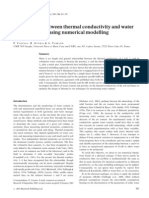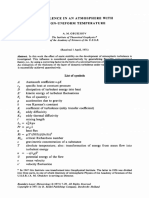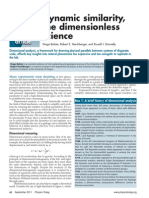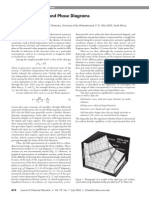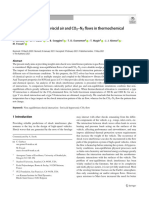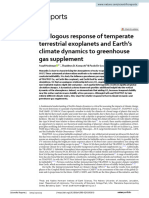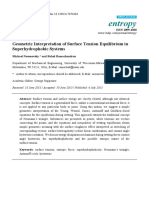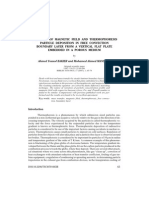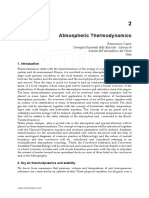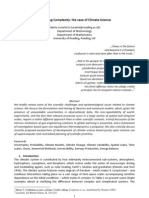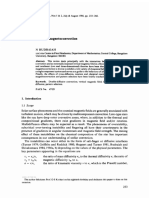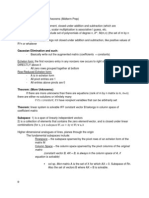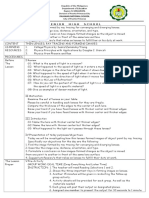Monin and Obukhov 1954
Monin and Obukhov 1954
Uploaded by
Nikolay ZavgorodniyCopyright:
Available Formats
Monin and Obukhov 1954
Monin and Obukhov 1954
Uploaded by
Nikolay ZavgorodniyCopyright
Available Formats
Share this document
Did you find this document useful?
Is this content inappropriate?
Copyright:
Available Formats
Monin and Obukhov 1954
Monin and Obukhov 1954
Uploaded by
Nikolay ZavgorodniyCopyright:
Available Formats
Basic laws of turbulent mixing in the surface layer
of the atmosphere
A.S. Monin and A.M. Obukhov
Originally published in Tr. Akad. Nauk SSSR Geophiz. Inst. 24(151):163-187,
1954.
This document is based on a translation from the original Russian by John Miller for
Geophysics Research Directorate, AF Cambridge Research Centre, Cambridge, Mas-
sachusetts, by the American Meteorological Society. Contract Number 19(604)-1936.
Department of the Army, Fort Detrick. Frederick, Maryland. Translation number
1234, January 1959. Complete rough draft. Unclassied.
The legibility of the available document is very poor in places and some of its scientic
terminology is a little awkward. To solve the rst problem, and make some improve-
ments on the second, reference was made to a second translation obtained from Frank
Bradley of CSIRO. The only indication of the source of this second translation is the
inscription L.S.G 13.3.1957 at its foot
. This second translation was also used to
cross-check some minor edits done during retyping into LaTeX. The references and
Figures are from the L.S.G. document (the former because Miller leaves these in the
original Russian, which is too hard to read given the poor reproduction, and the latter
because they are clearer in the L.S.G. translation). Even so, this document remains
basically a transfer of the Miller translation into LaTeX. I thank John Wilson for his
careful proof reading.
Keith McNaughton, 12/11/2008.
The translator may be LSG Kovasznay of Johns Hopkins University, who was active in turbu-
lence research at that time and translated at least one other paper on turbulence from Russian to
English. Kovasznay met A.M. Obukhov during the latters visit to the University in about 1957, so
the translation may have been done either as preparation for, or in the aftermath of, their meeting.
1
Abstract
The article contains an analysis of the processes of mixing in a turbulent
atmosphere, based on systematic application of the methods of the theory of
similitude. Empirical data on the distribution of wind velocity under various
conditions of temperature stratication are generalized and a method is pro-
posed for computing the austausch characteristics on the basis of measuring
wind velocity and temperature gradient.
Introduction
The questions of the physics of the surface layer have occupied a considerable
place in meteorological investigations during the past 10-15 years. The laws
of the processes in the surface layer are of interest not only to agrometeo-
rology, which studies the eect of a meteorological medium on the growth
of vegetation, but they also have a general geophysical signicance, since the
dynamic interaction of the atmosphere and the substrate, the feeding of the
atmosphere by moisture and heat, is realized through the surface layer.
A large amount of research in the eld of surface-layer physics has been
done at the Main Geophysical Observatory; the works of S.A. Sapozhnikova [1],
D.L. Laikhtman and A.F. Chudnovskii [2], M.I. Budyko [3] and M.P. Timofeev
[4] are well known to Soviet meteorologists.
This research has provided valuable observational data on the distribution
of wind, temperature and humidity in the surface layer, and a number of
specic propositions have been drawn up on the methodology for computing
turbulent austausch characteristics (Budyko, Laikhtman).
In this regard there are still a number of debatable questions in the theory
of surface-layer mixing. The simplest system of the logarithmic boundary
layer, borrowed from technical aerodynamics, describes quite well the phe-
nomena in a neutrally-stratied atmosphere, and is supported by much empir-
ical data. However, this system is insucient for describing processes in the
real atmosphere where the temperature inhomogeneity is an essential factor
inuencing the development of turbulence. This latter fact (the temperature
inhomogeneity) determines the specic nature of the problem of atmospheric
turbulence as applied to surface-layer physics.
The works of Laikhtman [5] and Budyko [3], as well as those of a number
of foreign researchers (Sverdrup, Rossby, Montgomery; see, e.g. [6]) have been
devoted to computing the inuence of temperature stratication on turbulent
exchange. The individual results of these works contradict one another; in
many respects the physical sense of the initial hypotheses is not clear. Thus,
e.g. Budyko proposes that the atmospheric stratication be considered within
2
the framework of the simplest system of the logarithmic boundary layer, for-
mally replacing the Karman universal constant by a variable parameter,
a function of stratication. In Budykos system the basic characteristic of
the substrate, roughness, is also a function of meteorological conditions. The
purely formal nature of those relations is one of the shortcomings of Budykos
system. It should also be noted that the observed proles of wind distribution
with height regularly deviate from the logarithmic law during stratication
conditions which dier from neutral equilibrium.
Laikhtman proposes a more complete method of approximating wind and
temperature proles (an exponontial law with a variable exponent), which
makes it possible to discern the nature of deviations from the logarithmic law
under various conditions of atmospheric stratication. However, Laikhtmans
system contains too many free parameters which have to be determined in
each individual case. This creates diculties familiar in determining these
parameters from empirical data and decreases the computational accuracy.
These critical remarks by no means are meant to detract from the value
of the results obtained by Budyko and Laikhtman when solving individual
problems; however, they indicate the necessity of devoloping the theory further
and making the initial physical hypotheses more exact.
When analyzing the highly complex phenomena of surface-layer turbulence,
where the temperature factors play an essential role, it is expedient to use the
methods of the theory of similitude which are widely used in applied aerody-
namics and thermal physics, and are the generally-accepted method of inves-
tigation in this area.
In 1943, A.M. Obukhov attempted to apply methods of the theory of simil-
itude to problems of surface-layer physics [7]. The results obtained in this work
were subsequently developed by A.S. Monin [8]. The theory developed in [7]
and [8] evidently gives a satisfactory qualitative description of the processes.
Furthermore, the data used in [7] to determine the numerical parmeters
in the proposed system were not suciently reliable (the critical Richardson
number was mistakenly assumed to be 1/11, on the basis of Sverdrups data),
which made it impossible to make direct use of the formulas obtained in this
work in actual computations.
The present work gives an analysis of the processes of turbulent mixing in
the surface layer of the atmosphere on the basis of a systematic application
of the methods of the theory of similitude, and the values of the numerical
parameters are more exactly dened by using a suciently large amount of
empirical data on gradient observations, obtained from the expeditions of the
Main Geophysical Observatory and the Geophysical Institute of the Academy
of Sciences of the USSR. On this basis, working formulas were obtained for
computing the basic characteristics of the surface layer, viz., turbulent heat
3
transfer, friction, the austausch coecient, and moisture ux, from gradient
measurement data. The computational method is illustrated by specic ex-
amples.
1 The logarithmic boundary layer
When analyzing the processes in the surface layer of the atmosphere on a
theoretical basis, we will proceed from the generally accepted system of a ow
over an innite, rough surface whose horizontal properties are assumed to be
quite uniform horizontally. The averaged characteristics of the ow in this
system are a function only of the vertical coordinate z. The most important
characteristics are the momentum, heat, and humidity uxes.
The momentum ux can be treated as turbulent friction stress. Instead of
turbulent friction
= u
(1)
where u
and w
are the uctuations of the horizontal and vertical wind velocity
components, is air density, and the bar indicates averaging, it is convenient
to examine the dynamic velocity
v
=
_
(2)
Within the connes of the surface layer, and the turbulent heat ux q
can be considered to be practically independent of height z.
The condition that uxes and q are constant (within the given tolerance)
can serve to determine the actual concept of the surface layer. Let us attempt
to give an approximate estimate of the height of the surface layer on the basis
of possible changes in . We will proceed from the averaged equations of
hydrodynamics in a Coriolis force eld. The corresponding equation for the x-
ooordinate (wind-velocity direction at the earths surface) in a quasistationary
case has the following forms
u
z
=
1
p
x
+ v (3)
where p/x is the pressure gradient, the Coriolis parameter and v the
compontent of averaged wind velocity along the y-axis.
Let us integrate both sides of the equation with respect to height within
the limits of a layer of thickness H and estimate the right-hand side:
(0) (H)
=
_
H
0
p
x
v
dz <
_
H
0
1
p
x
dz (4)
4
The discarding of term v leads to a strengthening of the inequality, since
the Coriolis force partially compensates the eect of the pressure gradient.
Introducing the dynamic velocity v
and the geostrophic wind velocity v
g
=
(1/) |p/x|, we can write the resultant inequality in the following form:
v
2
(0) v
2
(H) < Hv
g
(5)
Let us dene H such that the relative change of v
2
in a layer of thickness H
does not exceed the tolerance a, i.e.,
v
2
(0) v
2
(H)
v
2
(0)
a (6)
On the strength of inequality (5) it suces that
H <
av
2
(0)
v
g
(7)
in order that (6) be fullled. The ratio of friction velocity to geostrophic wind
velocity can be estimated to be of the order of 0.05:
v
v
g
0.05
from which it follows that
H 2.5 10
3
a
v
g
When v
g
10 m/sec and = 10
4
sec
1
we get
H a 250 m
With a tolerance a = 20% we get the estimate of the height of the surface
layer which we seek:
H = 50 m.
Within the limits of this layer, v
can be considered practically constant and
the eect of the Coriolis force (rotation of wind with height) can be neglected.
The estimate obtained agrees quite well with observations.
Under conditions of neutral stratication the processes of turbulent mixing
in the surface layer can be described by the logarithmic model of the boundary
layer. The corresponding laws have been studied in detail in experimental
aerodynamics, and are widely used in meteorology.
Let us recall the derivation of the logarithmic law of wind distribution
on the basis of the hypothesis of similarity. Let us assume that for values
5
of z h
1
, where h
1
is the height of the grass (the characteristic scale of
the micro-inhomogeneities of the substrate), the statistical characteristics for
relative movements in a stream are invariant with respect to the similarity
transformation
x
= kx, y
= ky, z
= kz, t
= kt.
In these transformations the half-space z > 0 transforms into itself, while the
equations of motion remain unchanged. This condition is the theoretical basis
for the assumed hypothesis of similitude. Let us also note that the natural
scale of velocity v
=
_
/ remains invariant with respect to the indicated
transformations. Let us examine the stationary regime and establish a ratio of
the dierence of the averaged velocities at two levels z
2
and z
1
to the dynamic
velocity v
. The corresponding non-dimensional magnitude is a function of z
1
and z
2
and, on the strength of the assumption of self similitude of the ow,
can be a function only of the ratio z
2
/z
1
:
v(z
2
) v(z
1
)
v
= f (z
2
/z
1
) (8)
Let us determine the form of function f(). Evidently for all three heights
z
3
> z
2
> z
1
u(z
3
) u(z
1
) = u(z
3
) u(z
2
) + u(z
2
) u(z
1
) (9)
and along with this,
z
3
z
1
=
z
3
z
2
z
2
z
1
(10)
From this it follows that function f satises the functional equation
f (
1
2
) = f (
1
) + f (
2
)
(
1
= z
2
/z
1
,
2
= z
3
/z
2
) (11)
The logarithmic function f() = C ln is the only solution of this functional
equation. Assuming C = 1/, we get
v(z
2
) v(z
1
)
v
=
1
ln
z
2
z
1
(12)
where is the well-known Karman constant. According to empirical data,
0.4. Equation (12) can be written in the usual dierential form, examining
the innitely close values z
2
and z
1
:
dv
dz
=
v
z
(13)
6
Equations (12) and (13) do not contain charateristics of a particular substrate
but can pertain to any substrate, if the condition z
1
, z
2
>> h
1
is satised.
1
Then, too, formula (13) species only changes in mean wind velocity with
height. The properties of the substrate must be considered in order to deter-
mine the absolute value of v(z).
Now let us assume that observations of wind velocity are conducted at a
denite height H above some denite substrate. Let us assume that we can
conduct independent measurements of the turbulent friction and, accordingly,
in each individual case we can determine v =
_
/. The value v
can be
determined, e.g. from thermo-anemometer meter observations of uctuations
u
and w
, or directly on the basis of measurement of the drag intensity at the
earths surface. This latter method is used in practice when studying turbulent
motion in tubes. Sheppard [9] attemptod to use the dynamometer method of
measuring under atmospheric conditions.
A comparison of a number of observations of v(H) and allows us to
determine the relationship between these magnitudes. Aerodynamic experi-
ments teach us that with large Reynolds nunbers and surface roughness the
dependence of on v is of a quadratic nature, from which it follows that
v
= (H) v(H) (14)
where (H) is a non-dimensional coecient which is a function of the proper-
ties of the substrate. At a xed height H the drag coecient (H) can serve
as an objective characteristic of the properties of the substrate with respect
to its dynamic inuence on the ow. However, use of (H) has the disadvan-
tage that a specic observation height must be selected. The dependence of
(H) on the observation height H can be easily established by substituting
v(H) = v
/(H) in formula (12). For any two heights H
1
, H
2
>> h
1
we will
have
1
(H
2
)
1
(H
1
)
=
1
ln
H
2
H
1
(15)
From (15) it follows that, in particular, (H) decreases with height. Taking
the antilogarithms and combining the magnitides which contain H
1
and H
2
respectively, we get
H
1
e
/(H
1
)
= H
2
e
/(H
2
)
= h
o
(16)
i.e., a magnitude which is not a function of height. Thus the magnitude h
o
,
which has length, is determined only by the properties of the substrate; it is
1
Determination of the values of height z in formula (13) involves a certain arbitrariness in the
choice of the starting point for the computation (within the limits of the height of the grass h
1
).
However, when z h
1
, this indeniteness is of no importance.
7
called dynamic roughess. Let us express the drag coecient (z) in terms
of h
o
:
(z) =
ln
z
ho
(17)
whence on the basis of (14) we get the desired wind velocity distribution:
v(z) =
v
ln
z
h
o
(18)
The method given above for introducing the concept of roughness of the
substrate has the advantage that it depends exclusively on the properties of
the ow at rather great heights, where there are sucient grounds for using
the universal laws of developed turbulence. In most cases, however, we have
no means for making direct measurements of (and, accordingly, (H)), and
in this regard, when making practical determinations of the characteristics of
dynamic roughness, we must use the properties of the wind prole which can be
determined directly from observations. When dealing with a mature vegetation
cover, additional diculties arise in connection with choosing the reference
height for specifying z. A number of authors (Paeschke [10] Konstantinov
[11]) recommend the use of a certain arbitrary level z
1
for the start of height
computations; this level lies between the soil and the top of the grass h
1
. This
level can be called the height of the displacement layer.
The concept of displacement height z
1
can be introduced into the gen-
eral system as follows. Equation (13) describes an asymptotic relationship
valid when z >> h
1
, and in this region it is insensitive to slight changes in
the reference point of z (within the limits of the grass heighth
1
). Let us now
examine the range of values of z which, although they exceed h
1
, are never-
theless comparable with it, so the ratio h
1
/z can be treated as a rst-order
value. To be specic, we will compute z from ground level. In this case, a
numerical correction factor f(h
1
/z) should be introduced into formula (13);
this describes the deviation from the automodular regime, connected with the
direct eect of the grass:
dv
dz
=
v
z
f
_
h
1
z
_
(19)
Evidently, when z , formula (19) should convert into (13), from which it
follows that f(0) = 1. Expanding function f in series, we get
dv
dz
=
v
z
_
1 + (h
1
/z) + (h
1
/z)
2
+ . . .
(20)
Let us now introduce a new starting point for computations of z, assuming
z = z
+ z
1
, where z
is comparable with h
1
, and rewrite the equation with
8
respect to the new variable:
d v
dz
=
v
_
1 +
_
z
1
h
1
_
(h
1
/z
) +
(h
1
/z
)
2
+ ...
_
(21)
Let us select z
1
such that in equation (21) the rst-order term reverts to zero.
With a corresponding choice of z
1
with an accuracy up to the second-order
terms, we get
d v
dz
=
v
(z z
1
)
(22)
Thus, the height of the displacement layer can be dened as the height of some
arbitrary level of computation, using which we get the best approximation of
the wind prole by the logarithmic law in a layer situated above the grass
layer. Let us note that the physical determination given above of dynamic
roughness h
o
is insensitive to a substitution of z z
1
for z (Since H >> h
1
);
however, in the nal formula for the wind velocity prole we should calculate
the height from the level of the displacement layer, i.e., replace z by z z
1
:
v(z) =
v
ln
z z
1
h
o
(23)
The characteristics of the substrate, z
1
and h
o
can be determined empiri-
cally on the basis of measurements of wind prole in the layer above the grass
level, under conditions close to equilibrium. To increase the computational
accuracy we should use data averaged for a group of analogous cases.
Let us use, as an example, values of z
1
and h
o
according to Paeschkes work
[10] (table 1):
Table 1
Characteristics of the substrate
z
1
, cm h
o
, cm
Snow surface 3 0.5
Airport 10 2.5
Sugar beet plantation 45 6.6
Wheat eld 130 5
Some data on the question of choosing the initial level z
1
can be found in
an article by A. R. Konstantinov [11]. It is worth noting that the dynamic
roughness of a wheat eld is less than that of a sugar beet plantation, although
the grass is three times higher in the rst case. In the case of a low grass stand
(steppe) the value of z
1
does not play an essential role, and when computing
h
o
and v
from observations made at heights of more than 1 meter, we can
9
consider formally that z
1
= 0, i.e., we can compute the height directly from
the ground.
In further sections of this work, when considering the eects of stratica-
tion, we will assume that height is calculated from some arbitrary level (the
displacement layer), not specically mentioned, while the dynamic roughness
length h
o
will be computed by some given characteristic of the substrate which
is independent of meteorological conditions.
2 Basic characteristics of the turbulent re-
gime in a medium with non-uniform tem-
perature
One of the most important practical characteristics of the turbulent regime in
the surface layer of the atmosphere is the vertical turbulent heat ux:
q = c
p
w
(24)
where c
p
is the specic heat of the air at constant pressure, is density, w
and
T
are, respectively, the uctuations of the vertical wind velocity component
and of temperature, caused by the turbulence elements passing a given point,
and the bar indicates averaging. The magnitude of q is the average amount
of heat carried by turbulent uctuations across a unit area per unit time. We
have sucient grounds for considering that for all intents and purposes the
turbulent heat ux q in the surface layer under stationary conditions is not a
function of height
2
. Instead of q we may use the temperature ux
q
c
p
= w
(25)
The magnitude of the turbulent heat ux q can be determined directly
experimentally, on the basis of electronic measurements of the uctuations of
temperature T
and of the vertical wind velocity w
. Modern technology has
shown that such measurements are possible, in principle [12, 13]. Nevertheless,
in practice one must still use indirect methods to determine q, based on sim-
pler gradient methods. To interpret these measurements correctly, one must
investigate the connection between the characteristics of turbulence q and v
2
Here we are digressing from an examination of radiational energy uxes. Strictly speaking, the
total ux q + q
1
is not a function of height; here q
1
is the radiation ux. Then, too, in the surface
layer, changes in the radiation ux q
1
can hardly be considered essential. This question, however
should be the subject of special investigations.
10
and the distribution of mean wind speed and temperature. When solving this
problem we will follow the methods of the theory of similitude and attempt to
establish a system with a minimum number of parameters which describe the
turbulent regime in an inhomogeneous temperature medium.
The inhomogeneities of the temperature eld, being of a systematic nature
(change of mean temperature with height), exert a denite inuence on the
general turbulent regime (the eect of Archimedian forces). Provided that the
temperature uctuations are slight compared with the mean temperature of
the layer T
o
, the equations for the dynamics of an inhomogeneous temperature
medium can be written in the following form:
du
dt
=
1
p
1
x
dv
dt
=
1
p
1
y
dw
dt
=
1
p
1
z
+
g
T
o
T
1
(26)
u
x
+
v
y
+
w
z
= 0
dT
1
dt
= 0
In this system p
1
and T
1
indicate deviations from the standard values.
The simplications made when deriving the system of equations are: ne-
glect of the Coriolis force and the radiation inux of heat, and also the lin-
earization of the standard statistical distribution of pressure and temperature.
This latter indicates that change in density due to pressure changes are ne-
glected, and it assumes that the deviation of density and temperature from the
standard values are proportional (L. D. Landau and E.M. Lifshitz [14, chapter
5]). These simplications, used in the convection theory, allow us to describe
the Archimedean force by the term (g/T
o
) T
1
. Thus, the equation contains
a dimensional constant g/T
o
, which we should consider in the future when
establishing the criteria of similitude.
Let us note that we cannot linearize the equations of velocity variations,
since in this case turbulence would be lost. In addition, in the equations,
the terms containing viscosity and heat conductivity would be omitted
3
. It
is natural to assume that changes in mean velocity and temperature with
3
Under conditions of a developed turbulent regime, these terms must be considered only when
investigating the very ne details of the microstructure of the wind and temperature elds. The
vertical transport of momentum and heat is caused by the inhomogeneities of some mean scale,
for which the direct inuence of viscosity and heat conductivity are rather slight.
11
height can be expressed by coordinate z, parameter g/T
o
, and the external
parameters v
and q while the corresponding equations can be written in
non-dimensional form, since they do not contain other dimensional constants.
This proposition is the basic hypothesis of the theory of similitude, formulated
in the rst section of the present work, generalized for the case of a medium
with a non-uniform temperature.
The similarity hypothesis which we have adopted agrees with equations
(26) and is equivalant to the proposition that the sytem of equations (26)
together with the conditions
w
=
q
c
p
= const
(27)
u
= = const
are an analogue of the boundary conditions and dene the statistical charac-
teristics of the turbulent regime unequivocally. Thus, the three parameters
g/T
o
, v
and q/c
p
can be considered the denitive characteristics of the tur-
bulence of the surface layer (in the layer above the top of the grass). From
these parameters we can establish unequivocally (with an accuracy of the nu-
merical coecients) the scale of length L and temperature T
, which can be
written in the following form:
L =
v
3
g
To
q
cp
, T
=
1
u
q
c
p
(28)
It is natural to use dynamic velocity v
as the characteristic velocity scale.
The minus sign and the Karman constant are introduced for the sake of
convenience. The signs of L and T
are determined by the nature or the
stratication. With stable stratication the turbulent heat ux is directed
downward, q < 0, and correspondingly L > 0 and T
> 0. With unstable
stratication on the other hand, q > 0, L < 0 and T
< 0. Thus, we must
visualize two qualitatively dierent regimes, corresponding to the cases q < 0
and q > 0. These regimes should unite as conditions of neutral stratication
(q = 0) are approached.
Let us examine the non-dimensional magnitudes
_
z
v
dv
dz
_
and
_
z
T
dT
dz
_
(from now on, the bar which indicates averaging will be omitted). These non-
dimensional characteristics of the averaged eld of velocities and temperatures
should be denite functions of the external parameters and of coordinate
z. The only non-dimensional combination which we can make from q/c
p
, v
,
g/T
o
and z is z/L, from which it follows that
z
v
dv
dz
=
1
_
z
L
_
(29)
12
z
T
dT
dz
=
2
_
z
L
_
(30)
or
dv
dz
=
v
z
1
_
z
L
_
(29
)
and
dT
dz
=
T
z
2
_
z
L
_
(30
)
where T
and L are determined by formula (28).
Let us introduce the concept of the austausch coecient. Let us assume
formally that
= K
dv
dz
(31)
q = c
p
K
T
dT
dz
and call the dynamic austausch coecient and the coecient of turbulent heat
conductivity K and K
T
respectively. Introducing the magnitudes v
=
_
/
and T
=
1
v
q
cp
in place of and q, and using equations (29) aid (30), we
get
K =
v
1
_
z
L
_, K
T
=
v
2
_
z
L
_ (32)
Now let us examine the hypothesis, shared by a majority of meteorologists,
that within the limits of meteorological observations we can consider that
K = K
T
4
from which it follows that
1
_
z
L
_
=
2
_
z
L
_
=
_
z
L
_
(33)
The similitude of the temperature and wind proles follows directly from the
accepted hypothesis that K = K
T
. Dividing (30) by (29) we get
dT
dv
=
q
c
p
=
T
(34)
4
Generally speaking K > K
T
since the eect of pressure uctuations, as well as mixing can be
expressed in a momentum exchange. However, as of now we have no convincing evidence that this
dierence is essential. The theory developed in the present work can be generalized for the case
K/K
T
= a = 1* if we replace T by T/a in all instances.
13
and, accordingly, for any heights H
1
and H
2
T(H
2
) T(H
1
) =
T
[v(H
2
) v(H
1
)] (35)
Thus, the ratio of the dierence of mean temperature at two levels H
1
and
H
2
to the dierence in velocities at the same heights does not depend on the
choice of heights H
1
and H
2
, but is determined entirely by external conditions
- the ratio of the turbulent heat ux q to the turbulent drag resistance .
Let us now show that the non-dimensional factor (z/L), where L =
v
3
/
_
g
To
q
cp
_
, is directly connected with the Richardson number at any given
level. Substituting the values dv/dz and dT/dz, determined from formulas (29)
and (30), in the expression for the Richardson number
5
Ri =
g
T
o
_
dT
dz
_
_
dv
dz
_
2
(36)
we get
Ri =
g
2
T
o
T
z
v
2
_
z
L
_ (37)
or, using the denition of the scale of L by (28)
Ri =
z
L
1
_
z
L
_ (38)
from which it follows that the dependence of the Richardson number on height
is dened by a single parameterthe scale L.
Comparing formula (32) for the austausch coecient with the expression
for the Richardson number, we get an important relationship between the
austausch coecient, the scale L and the Richardson number:
K = v
LRi (39)
Let us explain the physical the meaning of the L scale. Under any condi-
tions of stratication we have
dv
dz
=
v
z
_
z
L
_
(40)
5
It follows that T should indicate potential temperature, since T does not change with vertical
shifts of the turbulent elements (the state of the latter can be considered adiabatic). In the surface
layer the numerical values of potential and molecular temperature are very close. With the large
temperature gradients usually observed in the surface layer, the dierence between the gradients
of potential and molecular temperature are inconsequential; however, in states close to isothermy,
this dierence is signicant.
14
Let us x the value z and decrease magnitude q indenitely, approaching
the conditions of neutral stratication, which correspond to innite growth
of the scale L (with respect to absolute magnitude). Obviously, within this
range, we should obtain formula (22), from which it follows that
(0) = 1
Under given external conditions characterized by magnitudes v
and q, and
the corresponding magnitude of L, in the range of values of z which are quite
small compared to L, (z/L) will be quite close to unity. This indicates that
austausch conditions with z L dier little from austausch conditions in a
neutrally stratied atmosphere and, accordingly, turbulence is caused mainly
by purely dynamic factors. Thus, the scale L, rst introduced by Obukbov [7],
is an important physical characteristic of the state of the surface layer and can
be called the height of the sub-layer of dynamic turbulence. On the strength
of the fact that (0) = 1 and formula (38), when z 0, we get
1
L
=
_
Ri
z
_
z=0
(41)
This formula can serve as the basis for determining the scale L from empirical
data (from the wind and temperature proles).
The function (z/L) should, in the general case, be determined from the
aggregate of empirical data. It should be noted that the data available at
present are insucient to determine function reliably in a suciently wide
range of changes of the argument z/L. However, a number of important prob-
lems can be solved for the case z/L < 1, where we can limit ourselves to
the rst terms of function expanded in series. This case requires special
examination.
3 Determination of the turbulent charac-
teristics from data on gradient measurements
In the case |z/L| < 1 we can limit ourselves to the rst terms of the function
(z/L) expanded in a power series, and write
= 1 +
z
L
(42)
where is some universal constant which can be determined on the basis of
empirical data. From formulas (29), (30) and (42), by integrating with respect
15
to z, we get
v(z) =
v
_
ln
z
h
o
+
z
L
_
(43)
T(z) T(h
o
) = T
_
ln
z
h
o
+
z
L
_
Here we have replaced the term [(z h
o
)/L] by (z/L), with the intention
of using fornula (43) only when z h
o
.
Let us note that analogous formulas can be used to describe the proles
of the concentration of any passive substance in the surface layer of the at-
mosphere. For example, with a stationary turbulent regime with no phase
transformation of the humidity in the atmosphere, the vertical moisture ux
(rate of evaporation) E = w
(Q is specic humidity) can be considered
independent of height and, analogously to (30), we can set
dQ
dz
=
q
z
_
z
L
_
, Q
=
1
v
, (44)
whence
Q(z) Q(h
o
) = Q
_
ln
z
h
o
+
z
L
_
(45)
Finally, the expression for the. austausch coecient K = v
LRi, following
equation (38) and using the approximation (42), becomes
K(z) =
v
z
1 +
z
L
(46)
With neutral stratication (|L| = ) we get, from (43), the usual logarith-
mic formulas for wind and temperature distribution with height. Non-neutral
stratication is described in (43) by the component (z/L) and leads to a
systematic deviation from the logarithmic law. With unstable stratication
(L < 0), intense turbulent mixing leads to equalization of wind velocity in
dierent layers of the atmosphere, so that the wind velocity should increase
with height more slowly than in the case of neutral stratication, i.e., (z/L)
should be less than zero. Accordingly, > 0.
Formulas (43) for v(z) and T(z) are in good qualitative (and, with correct
selection of the parameters, also quantitative) agreement with the observed
proles of wind velocity and temperature in the surface layer. Actual measure-
ments conrm the presence and nature of regular deviations of the logarithmic
law in the wind and temperature distribution with height, indicated by formu-
las (43). This can be seen, e.g., from the data of Table 2, which shows wind
16
Figure 1: Nature of the wind and temperature proles
proles averaged by groups with an identical stability parameter S =
g
To
T
v
2
(taken from data of the Main Geophysical Observatory expedition of 1945 [15],
1947 [16] and 1950 [17] and the expedition of the Geophysical Institute of the
Academy of Sciences of the USSR in 1951 [18]. The form of proles v(z) and
T(z), in agreement with formulas (43), is given in Figure 1. Figures 2 and 3
give the averaged proles of wind velocity and temperature obtained by the
1951 expedition of the Geophysical Institute of the Academy of Sciences of the
USSR.
6
Halstead (19) proposed that the inuence of stratication be computed by
introducing correction factors into the logarithmic formulae, analogous to (43),
but without analyzing the coecients from the point of view of the theory of
similitude.
Approximating the measured wind and temperature proles by formulas
6
The straight dashed lines in gures 1, 2 and 3 correspond to the logarithmic prole. The
numbers -1, -2, . . . +3 correspond to the identication number of the group of proles in Table 2.
17
Figure 2: Averaged wind proles from observational data.
(43), we can determine the turbulence characteristics from gradient measure-
ment data. In practice, during such an approximation we must rst determine
the reference level for computing height z
1
the thickness of the displacement
layer. The magnitude z
1
can be determined experimentally, so that on the
graph with the logarithmic scale the wind prole, corresponding to cases of
equilibrium stratication (i.e., actually, to cases of isothermy) would be de-
picted by straight lines with respect to height. Extrapolating the resulting
rectilinear wind prole graph to zero velocity, we get the value of the rough-
ness height h
o
.
The magnitude h
o
and the parameters v
/ and /L which enter into
formulas (43) can be most accurataly determined by using the least-squares
18
Figure 3: Averaged temperature proles from observational data.
method to process the wind prole measured at the same station, generally
speaking, under various conditions of straticatlon. Thus, assuming
v
i
(z) = A
i
( + log z) + C
i
z
where i is the number of a prole, and selecting A
i
, and C
i
because of the
requirement that the sum of the squares of the deviations be minimum,
2
=
i,k
[A
i
( + logz
k
) + C
i
z
k
v
i
(z
k
)]
2
(47)
we get for each prole
v
=
A
i
ln 10
,
L
=
C
i
A
i
ln 10
and we get a common roughness height h
o
= 10
for all proles.
19
Having determined /L for each prole by the indicated method, knowing
h
o
, and computing the value of the stability parameter S =
g
To
T(z
1
)T(z
3
)
v
2
(z
2
)
(where e.g., z
1
= 0.5, m z
2
= 1 m, z
3
= 2 m), we can determine using the
formula
S =
1
L
ln z
1
/z
3
_
ln
z
2
ho
_
2
1 +
L
z
1
z
3
ln z
1
/z
3
_
1 +
L
z
2
ln z
2
/ho
_
2
_
_ =
1
L
_
(48)
which follows from [43]. The number can be determined as the regression
coecient of values of (/L), computed from the previously calculated /L,
for the computed values of S. The regression coecient , computed from
the data of the four expeditions listed in Table 2, is 0.62; the accuracy in
determining in this case is probably not better than 10%. A determination
of from the data of just one Main Geophysical Observatory expedition [16]
yielded a value of 0.57.
Using formulas (43) we can compute the drag velocity v
, as well as the
turbulence characteristic which has the most practical value, i.e. the heat ux
q, using the results of wind velocity and temperature measurements at only
two heights. For example, let z
1
= H/2, z
2
= H, z
3
= 2H and let us assume
the values T
1
= T(z
1
), T
3
= T(z
3
) and v
2
= v(z
2
) m/sec have been measured.
Then from (43) we get
v
=
v
2
ln
z
2
ho
_
1 +
ln
z
2
ho
H
L
_ =
0.19
log
ho
H
v
2
_
1
0.26
log
ho
H
H
L
_ m/sec
(49)
q =
c
p
v
2
(T
3
T
1
)
ln
z
3
z
1
_
1 +
z
3
z
1
H ln
z
3
z
1
H
L
_ = 0.58
v
2
(T
3
T
1
)
1 + 0.65
H
L
Cal/cm
2
/min
Here we used the value = 0.43 for the von Karman constant. The magnitude
of H/L is determined from the relationship (48), which assumes the form
L
H
=
0.26
log
ho
H
+
1
2B
_
_
1 +
_
1 + 4B
_
0.65 +
0.26
log
ho
H
_
_
_
(50)
where B = .107 H (log z
o
/H)
2
_
(T
3
T
1
)/v
2
2
_
and H and v
2
are expressed in
meters and m/sec, respectively.
The inuence of stratication on the magnitudes v
and q is expressed by
the appearance of the components with H/L in the denominators of formulas
20
(49). As a rule, the correction for stratication appears to be slight (H/L
10
1
), which is natural, since turbulence in the lower part of the surface layer
is determined essentially by the dynamic factors.
Formulas (49) and (50) can be useful when mass-processing the gradient
measurement data. They assume a relatively simple form in situations where
h
o
and H are xed. For example, when h
o
= 1 cm and H = 1 m, we have
B = 0.43
T
3
T
1
v
2
2
; L = 0.13 +
1
2B
_
1 +
1 + 2.1B
_
m
(51)
v
=
0.095 v
2
1 +
0.13
L
m
sec
; q = 0.58
v
(T
1
T
3
)
1 +
0.65
L
cal
cm
2
min
Examples of computation of the turbulent heat ux q (from data of the
Geophysical Institute of the Academy of Sciences expedition of the USSR of
1951) are given in [18]. Computations using specic data show that the scale
of L is usually of the order of 10 m, and approaches 3-4 m only in speoic
cases with great instability or abrupt inversions. In cases close to isothermy,
L reaches values of several tens of meters. The drag velocity v
is about 8% of
the wind velocity at 8 m with unstable stratication, and about 5% with with
stable stratication. In the summer in Kazakhstan the turbulent heat ux q
reaches 0.25-0.35 cal/cm
2
min on hot sunny days, while it is of the order of
0.06 cal/cm
2
min at night.
Considering that some researchers use the formulae proposed by Budyko
[3] and Laikhtman [5] when determining the turbulence characteristics from
gradient measurement data, let us derive the relationship between the scale
of L and thebasic parameters of theBuyko and Laikhtman formulas. Budyko
approximates the wind proles by the logarithmic law
v(z) =
v
m
ln
mz
h
o
(52)
where m is a parameter which is a function of atmospheric stratication
(with neutral stratication, m reverts to unity). Equating the expressions
for v(z
2
)/v(z
1
), computed from the formulae (43) and (52), we get the ratio
L
=
ln m ln
z
2
z
1
z
1
ln
z
2
ho
z
2
ln
z
1
ho
+ (z
1
z
2
) ln m
(53)
Taking the limit where z
2
z
1
= H, we get
H
L
=
ln m
1 ln m + ln
ho
H
(54)
21
D.L. Laikhtman approximates the wind prole by the power law
v(z) = v(z
1
)
z
o
z
1
h
o
(55)
where is a parameter which is a function of atmospheric stratication (with
neutral stratication, reverts to zero). Equating the expression for v(z
2
)/v(z
1
),
computed from formulae (43) and (55), we get the relationship
L
=
(z
2
h
o
) ln
z
1
ho
(z
1
h
o
) ln
z
2
ho
z
2
(z
1
h
o
) z
1
(z
2
h
o
)
(56)
Taking the limit as z
2
z
1
= H we get
H
L
=
ln
H
ho
_
1
_
ho
H
_
_
1
_
ho
H
_
(57)
Taking advantage of the fact that the value of is insignicantly small, and
expanding the right side of (57) in series according to the -exponents, we get
the approximation
H
L
2
ln
2 ho
H
1 + ln
H
ho
(58)
4 Asymptotic formulas for the universal func-
tion
From formulas (30) and (40) it follows that in a stationary turbulent surface
layer, the wind an temperature proles can be described using one universal
function of z/L. Thus, integrating (30) with respect to z and setting f() =
_
()d
we obtain
v(z) =
v
_
f
_
z
L
_
f
_
h
o
L
__
(59)
T(z) = T(h
o
) + T
_
f
_
z
L
_
f
_
h
o
L
__
In the present section we will investigate the form of the universal function
f(z/L) taken as a whole.
22
Since () 1 when 0 with small z/L the function f(z/L) is of an
asymptotically logarithmic nature
f
_
z
L
_
ln
z
L
+ const. when
z
L
1 (60)
With large z/L the asymptotic behavior of function f(z/L) will dier in cases
of unstable (L < 0) or stable (L > 0) straticatlon, since in these cases there
are actually two qualitatively dierent regimes of turbulent motions.
To analyze the case of unstable stratication, rst let us examine the limit-
ing case of purely thermal turbulence (with no wind). In this case, due to the
lack of an averaged wind, the friction stress, on average will be zero (v
= 0),
while the turbulence regime is characterized by only the parameters q and g/T
o
(the turbulence receives its energy exclusively from the Instability energy, and
therefore is a function only of the degree of instability, characterized by the
heat ux q > 0 and of the magnitude of the Archimedean forces, characterized
by the parameter g/T
o
).
We cannot form a length scale from the parameters q and g/T
o
; therefore,
the regime of purely thermal turbulence is automodular
, i.e. all its charac-
teristics are combinations of q, g/T
o
and z. From dimensional considerations
we get
T(z) = T
+
C
4/3
_
q
c
p
_
2/3
_
gz
T
o
_
1/3
(61)
where C is the non-dimensional (universal) constant, the factor
4/3
is intro-
duced for convenience, and T
is a constant which has a temperature dimen-
sion.
From (61) it is evident that with an increase in height the distribution of
temperature approaches isothermy
8
This is natural, since in the case of un-
stable stratication at great heights, large turbulent elements develop (whose
dimensions are limited only by the distance to the earths surface), bringing
about very intense mixing of the air, which leads to an equalization of the
temperature prole.
From (61) it follows that the austausch coecient
K =
q
c
p
dT
dz
=
3
C
_
q
c
p
_
1/3
_
g
T
o
_
1/3
(z)
4/3
(62)
increases rapidly with height, which is explained by the augmentation of the
Editorial note: This word is translated by LSG as self patterning (with quote marks).
8
In (61) we are speaking of the approach to potential isothermy with an increase in height
(see footnote 5).
23
turbulent elements with an increase in height and simultaneous increase in the
intensity of the uctuations.
9
Formally, formula (61) can be written
T(z) T(h
o
)
T
= C
_
z
L
_
1/3
C
_
h
o
L
_
1/3
(63)
so that in the case of purely thermal turbulence, the universal function f(z/L)
(determined to within an additive constant) has the form f(z/L) = C (z/L)
1/3
+ const.
The case of purely thermal turbulence can be derived from the general case
of unstable stratication by passage to the limit with v
0. Here L 0
and z/L . Therefore the asymptotic behavior of the universal function
f(z/L) is determined by the relationship
f(z/L) C (z/L)
1/3
+ const. when z/L 1 (64)
This result indicates that at great heights z L (in the surface layer) the
turbulent regime, in the case of unstable stratication, is determined mainly
by thermal factors (the wind prole is smoothed, and turbulence receives its
energy mainly from the energy of turbulent instability, not from the energy of
the average motion).
An explanation of the asymptotic behavior of the function f(z/L) when
z L in the case of stable stratication, requires that we introduce additional
concepts. Turbulence decays in the limiting case of abrupt inversion with a
vanishingly weak wind. The existence of large turbulent elements becomes
impossible in the case of stable stratication (since they must expend too
much energy on opposing the Archimedean forces), and turbulence can exist
only in the form of small eddies. Large waves cannot lose stability, which is
natural from the point of view of the theory of stability. In this case turbulent
exchange between dierent atmospheric layers is hampered and turbulence
takes on a local character; at rather high altitudes z L (or, to put it
another way, with strong stability, that is with small L > 0) the turbulence
characteristics evidently cannot be functions of the distance z to the substrate.
This pertains, in particular, to the mixing coecient K and, accordingly, also
to the Richardson number Ri.
Thus, we may consider that in the case of stable stratication with an
increase in height z, (or, with an increase in stability, i.e., a decrease in L) the
9
The concepts here presented on the regime of purely thermal turbulence agree with the system
proposed by A. A. Skvortsov [20], with the sole dierence that Skvortsov introduces a concept of
the discrete spectrum of the scales of turbulent structures, while in the system presented here, the
spectrum of the scales is assumed to be continuous.
24
coecient of mixing K and the Richardson number Ri tend toward certain
constant values. This is natural, since with an increase in stability, K evidently
cannot increase, while Ri cannot decrease. Accordingly, there is a (universal)
value R of the Richardson number, which is such that when z/L 1,
Ri R = const., K v
LR (65)
The limiting value of R evidently cannot be greater than the critical value
Ri
cr
, but since, asymptotically, K = 0, i.e., turbulence does not completely
degenerate, R should be less than Ri
cr
. The limiting value obtained will be
called the stationary Richardson number.
From (65) it follows that when z/L 1, f
() 1/R, or
f(
z
L
)
1
R
z
L
+ const. (66)
Then we have
v(z)
1
R
g
T
o
q
c
p
z
v
2
+ const. (67)
T(z)
1
R
g
T
o
_
q
c
p
_
2
z
v
4
+ const. (68)
Our formulas (60), (64) and (66) show the behavior of function f() when
|| 1, 1 and 1, respectively.
For an empirical determination of the universal function f() in a su-
ciently broad range of changes in the parameter , using the data of the four
expeditions, given in table 2, and determining v
and L (when = 0.6) for
each wind prole, we construct the empirical universal function
_
v(z) v
_
|L|
2
__
= f
_
z
L
_
f(
1
2
)
where the plus sign corresponds to stable stratication and the minus sign to
unstable stratication.
The empirical points obtained are plotted on the graph in Figure 4. The
graph gives convincing evidence of the suitability of the hypotheses of simili-
tude used in the present work; these hypotheses reduce to the existence of a
single universal function f(z/L). The empirical points lie along smooth curves
with a very small scatter, despite the inaccuracies of the wind measurements
and the computation of L and v
by the approximation methods shown above.
Some scatter of the points is noted only in highly stable cases. The drawing
shows the limiting behavior of the curve quite well for the case of high stability
(approaching a linear prole) and high instability (approaching a constant).
25
Table 2
Wind proles determined from data grouped according to stability parameter
Main Geophysical Observatory Expedition 1945; z
o
= 0.2 cm.
Code
No.
No. of
Pro-
les
100 S Wind velocity (m/s) at the height (m)
v
S
L
L
0.2 0.5 1.0 2.0 5.0 10.8
-2 18 -3.47 0.55 0.74 0.94 1.21 1.72 2.40 0.13 0.94 0.68
-1 6 -0.52 1.21 1.49 1.76 2.10 2.78 3.80 0.25 0.57 1.0
0 30 0.25 2.41 2.90 3.25 3.60 4.10 4.56 0.50 0.01 46.2
1 21 0.56 1.69 2.00 2.24 2.43 2.68 2.85 0.36 -0.07 -8.2
2 10 1.49 1.32 1.58 1.70 1.82 1.97 2.02 0.27 -0.11 -5.6
Main Geophysical Observatory Expedition 1947; z
o
= 0.5 cm.
Code
No.
No. of
Pro-
les
100 S Wind velocity (m/s) at the height (m)
v
S
L
L
0.5 1.0 2.0 5.0 9.0 14.5
-4 8 -5.73 0.74 0.91 1.08 1.40 1.61 1.86 0.16 0.23 2.6
-3 13 -0.91 1.09 1.32 1.48 1.76 1.88 2.08 0.25 0.04 16.2
-2 9 -.37 1.24 1.50 1.67 1.93 2.03 2.03 0.28 0.002 300.0
-1 13 -0.18 1.68 2.00 2.22 2.57 2.73 2.92 0.37 0.01 -54.5
0 22 0 1.90 2.24 2.51 2.84 2.95 3.26 0.42 -0.02 -30.0
1 37 0.09 3.36 3.93 4.41 4.88 5.15 5.57 0.75 -0.65 -11.1
2 41 0.26 2.66 3.15 3.50 3.80 3.98 4.18 0.60 -0.07 -9.1
3 38 0.44 2.44 2.91 3.18 3.54 3.63 3.84 0.56 -0.07 -8.8
4 19 0.57 2.24 2.61 2.85 3.12 3.16 3.36 0.50 -0.08 -7.0
5 24 0.74 2.02 2.35 2.60 2.81 2.82 3.00 0.45 -0.08 -6.4
6 14 0.55 1.85 2.13 2.34 2.56 2.60 2.75 0.41 -0.09 -6.8
7 9 1.47 1.32 1.53 1.64 1.83 1.80 1.89 0.29 -0.11 -5.7
26
Main Geophysical Observatory Expedition 1950; z
o
= 0.8 cm.
Code
No.
No. of
Pro-
les
100 S Wind velocity (m/s) at the height (m)
v
S
L
L
0.5 1.0 2.0 4.0 8.0 15.0
-6 19 -8.42 0.54 0.65 0.80 1.00 1.31 1.80 0.12 0.46 1.3
-5 9 -1.92 0.89 1.04 1.22 1.50 1.94 2.50 0.20 0.29 2.1
-4 16 -1.18 1.05 1.25 1.45 1.76 2.16 2.58 0.25 0.18 3.3
-3 15 -0.46 1.52 1.79 2.04 2.34 2.74 3.25 0.36 0.09 6.4
-2 17 -0.24 1.80 2.12 2.42 2.76 3.19 3.66 0.43 0.06 10.3
-1 14 -0.13 2.02 2.38 2.70 3.06 3.50 4.00 0.49 0.04 14.3
0 25 -0.03 2.76 3.21 3.69 4.14 4.59 5.00 0.66 -0.01 -66.7
1 27 -0.09 3.35 3.90 4.48 5.00 5.52 6.08 0.75 -0.01 -66.7
2 25 0.14 2.48 2.90 3.33 3.94 4.10 4.40 0.60 -0.03 -20.0
3 29 0.22 2.40 2.80 3.20 3.55 3.88 4.15 0.58 -0.04 -17.1
4 26 0.26 2.46 2.86 3.25 3.60 3.88 4.10 0.60 -0.05 -11.5
5 26 0.29 2.40 2.75 3.10 3.45 3.80 4.10 0.57 -0.03 -12.4
6 32 0.36 2.28 2.50 2.84 3.16 3.46 3.42 0.52 -0.04 -15.0
7 116 0.46 2.04 2.38 2.69 2.98 3.20 3.40 0.50 -0.05 -11.5
8 18 0.66 1.68 1.94 2.19 2.40 2.62 2.80 0.41 -0.05 -12.5
9 22 0.25 1.44 1.65 1.88 2.04 2.20 2.34 0.35 -0.06 -10.2
10 15 1.22 1.25 1.44 1.61 1.76 1.90 2.00 0.30 -0.06 -9.2
11 19 1.83 1.00 1.14 1.30 1.43 1.53 1.56 1.56 -0.08 -7.7
12 15 4.06 0.73 0.84 0.94 1.02 1.08 1.10 1.18 -0.09 -6.4
Geophysical Institute of the Academy of Sciences Expedition 1951; z
o
= 1.0 cm.
Code
No.
No. of
Pro-
les
100 S Wind velocity (m/s) at the height (m)
v
S
L
L
0.5 1.0 2.0 4.0 8.0 15.0
-2 6 -.64 1.32 1.65 1.91 2.31 2.93 3.91 0.33 0.32 1.8
-1 11 -.21 1.83 2.14 2.55 3.05 3.71 4.62 0.45 0.20 3.0
0 10 0.02 2.97 3.53 4.04 4.72 5.20 5.86 0.76 0.02 24.0
1 7 0.17 4.01 4.64 5.25 5.80 6.41 6.88 1.01 -0.03 -18.2
2 19 0.36 3.09 3.60 4.04 4.45 4.77 5.07 0.79 -0.06 -10.3
3 8 0.81 2.23 2.55 2.86 3.10 3.28 3.45 0.56 -0.08 -7.6
27
Figure 4: Distribution of wind velocity in non-dimensional coordinates
28
References
[1] Sapozhnikova, S. A.: Wind velocity variation with height in the lower
layer of the atmosphere. Transactions, N.I.U. G.U.G.M.S. No. 33, 1946)
[2] Laikhtman, D. L. and A. F. Chudinovskii: Physic of the surface layer
of the atmosphere. (G.T.T.I., 1949, 254 pp.)
[3] Budyko, M.I.: Evaporation in natural conditions. (Gidrometeorizdat,
1948, 135 pp.)
[4] Timofeev, M. T.: On the methods of determination of the components
of the heat balance of the underlying surface. (Transactions G.G.O. Issue
27(89) 1951)
[5] Laikhtman, D. L.: Wind prole and the exchange in the surface layer
of the atmosphere ( Bull. A. Sc. USSR, Geogr. & Geophys. Series 8(1), 1944)
[6] Sutton, 0. G.: Atmospheric Turbulence. (London, 1949. 107 pp.)
[7] Obukhov, A.M.: Turbulence in the temperature-heterogeneous atmo-
sphere (Trans. Inst. Theoretical Geophysics, 1, 95-115. 1948)
[8] Monin, A.S.: Temperature regime in the surface layer of air. (Informa-
tion Bull. G.U.G.M.S. No. 1, 13-27, 1950.)
[9] Sheppard, P.A.: The aerodynamic drag of the earths surface and the
value of von Karmans constant in the lower atmosphere, (Proc. Roy. Soc. A,
188: 201-222, 1947)
[10] Paeschke, W.: Experimental investigation on the problems of rough-
ness and stability in the surface layer of the atmosphere. (Beit. Phys. fr Atm.
24(3), 1937)
[11] Konstantinov, A. R. Computation of evaporation from agrictiltural
elds, taking into account the eects of forest strips (Trans. State Hydrological
Institute, 34(88), 1952
[12] Obukhov, A.M.: Characteristics of the microstructure of the wind in
the surface layer of the atmosphere, (Bull. A. Sc. USSR Geophys Series 3,
49-68,1951),
[13] Krechmer, S.L.: . Investigations of the microuctuations of the tem-
perature eld in the atmosphere, (D.A.N. USSR, 84(1), 55-58, 1952)
[14] Landau, L.D. and Lifshitz, E.W.: Mechnics of continuous media.
(Chapter 5). O.T.T.L. 1944.
[15] Sapozhnikova, S. A.: Some characteristics of the distribution of tem-
perature, humidity and wind in the surface layer of the atmosphere. (Trans.
N.I.U.,G.U.G.M.S. USSR, Ser. 1 Meteorology, No. 39, 45-57, 1947.
[16] Sapozhnikova, S. A.: Methods of investigating turbulent exchange by
means of observational data in the lower atmosphere. (Trans. G.G.O. 16(78):
25-51,1949).
29
[17] Sapozhnikova, S. A.: Investigation of the eect of forest plantings on
the wind velocity, radiation balance and turbulent exchange in a eld. (Trans.
G.G.O. 19(91),1952)
[18] Monin, A.S.: 0n the mechanism of heating of the air in open steppe.
(Climatological and microclimatological investigations in pre-Caspian lowland.
A. Sc. USSR, 1953, pp. 100-123)
[19] Halstead, M.: A stability term in the wind gradient equation. (Trans.
Am. Geoph. Un. 1943)
[20] Skvortsov, A.A.: Evaporation and exchange in the surface layer of the
atmosphere. (Trans. Inst. of Energetics, A.Sc. U.Z.S.S.R. Tashkent, 1947)
30
You might also like
- Reinforced Concrete by Nadim HassounDocument5 pagesReinforced Concrete by Nadim HassounMauricio SanchezNo ratings yet
- Sn003a en EuDocument13 pagesSn003a en Eukopernik1977No ratings yet
- The Flat-Earth Approximation To The Solution of Electromagnetic PDocument95 pagesThe Flat-Earth Approximation To The Solution of Electromagnetic PVuglaShemmanNo ratings yet
- Martinez Hw1Document6 pagesMartinez Hw1Fernando Arellano GuerreroNo ratings yet
- Atmospheric Boundary Layer Flows PDFDocument304 pagesAtmospheric Boundary Layer Flows PDFkarolinesuellyNo ratings yet
- Salidau 2Document64 pagesSalidau 2Jose VargasNo ratings yet
- Cosenza Etal Thermal Conductivity Model 2003Document8 pagesCosenza Etal Thermal Conductivity Model 2003Uday Prakash SahuNo ratings yet
- Atmospheric Sciences: JT Schoof, Southern Illinois University, Carbondale, IL, USADocument3 pagesAtmospheric Sciences: JT Schoof, Southern Illinois University, Carbondale, IL, USAMonica BrownNo ratings yet
- Energies 12 00025Document16 pagesEnergies 12 00025Luca Ribba EstevaNo ratings yet
- Asplund Et Al 2005Document14 pagesAsplund Et Al 2005macarenaNo ratings yet
- Jet Stream and Long Waves in A Steady Rotating-Dishpan Experiment Structure of The CirculationDocument18 pagesJet Stream and Long Waves in A Steady Rotating-Dishpan Experiment Structure of The CirculationDamien Lune BleueNo ratings yet
- Efficiency and Optimization of Straight Fins With Combinate Heat and Mass TransferDocument10 pagesEfficiency and Optimization of Straight Fins With Combinate Heat and Mass TransferMauro De La RosaNo ratings yet
- Mantle Convection As A Boundary Layer PhenomenonDocument39 pagesMantle Convection As A Boundary Layer PhenomenonCamiloLozanoNo ratings yet
- Surface Self-Diffusion of Hydrogen On Cu 100: A Quantum Kinetic Equation ApproachDocument13 pagesSurface Self-Diffusion of Hydrogen On Cu 100: A Quantum Kinetic Equation ApproachbennyNo ratings yet
- BF 00718085Document23 pagesBF 00718085Hsu Tien-YiaoNo ratings yet
- Dimensional Analysis ArticleDocument0 pagesDimensional Analysis ArticleDuong Quoc DatNo ratings yet
- BGK Collision ModelDocument15 pagesBGK Collision ModelVineeth MaxxNo ratings yet
- Pearson 1958 On Convection Cells Induced by Surface TensionDocument12 pagesPearson 1958 On Convection Cells Induced by Surface TensionChong Jen Haw100% (1)
- Atmospheric Models: Pave PilićDocument7 pagesAtmospheric Models: Pave Pilićtrstenik994No ratings yet
- Transport PhenomenaDocument26 pagesTransport PhenomenaGiova RossiNo ratings yet
- Lecture 2 NotesDocument13 pagesLecture 2 Notesonesmus AnyimuNo ratings yet
- Equations of State and Phase DiagramDocument3 pagesEquations of State and Phase DiagramRorschachKovacsNo ratings yet
- Hasselmann - Stochastic Climate ModelsDocument13 pagesHasselmann - Stochastic Climate ModelsPeter HanappeNo ratings yet
- Course Details: Course Details:: Course Coordinator: Email: Office LocationDocument12 pagesCourse Details: Course Details:: Course Coordinator: Email: Office LocationHephzibah EniloloboNo ratings yet
- Fullfilling Magnetostatic ConditionsDocument12 pagesFullfilling Magnetostatic ConditionsDanielStauffenbergNo ratings yet
- Shock Interactions in Inviscid Air and CO2 in Thermochemical Nonequilibrium Using SU2 NEMODocument15 pagesShock Interactions in Inviscid Air and CO2 in Thermochemical Nonequilibrium Using SU2 NEMOsustainerspenNo ratings yet
- Berg Chap02Document84 pagesBerg Chap02Jahangir MalikNo ratings yet
- SM Chapter 01Document24 pagesSM Chapter 01Jaspher SonajoNo ratings yet
- Scott 1995 ADocument23 pagesScott 1995 ALeonardoAlejandroMingariNo ratings yet
- Rohrmann 2005Document32 pagesRohrmann 2005Andrés F. CáceresNo ratings yet
- EffectDocument10 pagesEffectDavide CagnoniNo ratings yet
- Banerjee&Turney2013 - Air-Water Gas Transfer and Near-Surface MotionsDocument37 pagesBanerjee&Turney2013 - Air-Water Gas Transfer and Near-Surface MotionsLeandro DijonNo ratings yet
- Analogous Response of Temperate Terrestrial Exoplanets and Earth's Climate Dynamics To Greenhouse Gas SupplementDocument12 pagesAnalogous Response of Temperate Terrestrial Exoplanets and Earth's Climate Dynamics To Greenhouse Gas Supplementhipoteticamente.contactoNo ratings yet
- IntroDocument4 pagesIntrolol30315orzNo ratings yet
- Mellor & Yamada - Support DocsDocument20 pagesMellor & Yamada - Support DocsLeonardo MichelsNo ratings yet
- Entropy: Geometric Interpretation of Surface Tension Equilibrium in Superhydrophobic SystemsDocument17 pagesEntropy: Geometric Interpretation of Surface Tension Equilibrium in Superhydrophobic SystemsZang NguyenNo ratings yet
- Classical Tests of Multidimensional Gravity: Negative ResultDocument4 pagesClassical Tests of Multidimensional Gravity: Negative ResultHazieqahNo ratings yet
- Unsteady MHD Flow of Radiating and Reacting Fluid Past A Vertical Porous Plate With Cosinusoidally Fluctuating TemperatureDocument17 pagesUnsteady MHD Flow of Radiating and Reacting Fluid Past A Vertical Porous Plate With Cosinusoidally Fluctuating Temperaturerakesh_lectNo ratings yet
- AttachmentDocument16 pagesAttachmentRodrigo Uriona TerrazasNo ratings yet
- Capillary Conduction of Liquids PDFDocument17 pagesCapillary Conduction of Liquids PDFAsh KongNo ratings yet
- 05 BakierDocument10 pages05 BakiergarridolopezNo ratings yet
- Microstructure-Based Random Finite Element Method Simulation of Frost Heave Theory and ImplementationDocument11 pagesMicrostructure-Based Random Finite Element Method Simulation of Frost Heave Theory and ImplementationShaoyang DongNo ratings yet
- Cloud ForcingDocument33 pagesCloud ForcingDakota435No ratings yet
- Laminar Forced Convection Heat and Mass Transfer of Humid Air Across A Vertical Plate With CondensationDocument11 pagesLaminar Forced Convection Heat and Mass Transfer of Humid Air Across A Vertical Plate With Condensationait hssainNo ratings yet
- Modeling of The Earth's Planetary Heat Balance With Electrical Circuit AnalogyDocument6 pagesModeling of The Earth's Planetary Heat Balance With Electrical Circuit AnalogyedgarjoNo ratings yet
- Two-Dimensional Numerical Simulation of The Combined Heat Transfer in Channel FlowDocument13 pagesTwo-Dimensional Numerical Simulation of The Combined Heat Transfer in Channel FlowAnonymous pKuPK3zUNo ratings yet
- The Stable Stationary Value of The Earth's Global Average Atmospheric Planck-Weighted Greenhouse-Gas Optical ThicknessDocument21 pagesThe Stable Stationary Value of The Earth's Global Average Atmospheric Planck-Weighted Greenhouse-Gas Optical ThicknessAlfred NobelNo ratings yet
- Dynamics WaterDocument22 pagesDynamics WatermohaninanitsNo ratings yet
- Elder 1967Document22 pagesElder 1967ALEJANDRO GANCEDO TORALNo ratings yet
- Problems of Modeling Climate and Climate Change: V. P. Dymnikov, V. N. Lykosov, and E. M. VolodinDocument18 pagesProblems of Modeling Climate and Climate Change: V. P. Dymnikov, V. N. Lykosov, and E. M. VolodinFikri ApriyonoNo ratings yet
- 2018 Interplanetary External Driven Geo Dynamo As The Origin of The Geomagnetic Jerks Aligned With Length of Day Variations and Gravity AnomaliesDocument52 pages2018 Interplanetary External Driven Geo Dynamo As The Origin of The Geomagnetic Jerks Aligned With Length of Day Variations and Gravity AnomaliesWI TONo ratings yet
- Atmospheric Thermodynamics: Consiglio Nazionale Delle Ricerche - Istituto Di Scienze Dell'atmosfera e Del Clima ItalyDocument25 pagesAtmospheric Thermodynamics: Consiglio Nazionale Delle Ricerche - Istituto Di Scienze Dell'atmosfera e Del Clima ItalySha ArsNo ratings yet
- Clim-Jcli3611 1Document14 pagesClim-Jcli3611 1theodoradoukainaNo ratings yet
- Jonathan Tennyson - The Molecular Opacity Problem For Models of Cool Stars and Brown DwarfsDocument5 pagesJonathan Tennyson - The Molecular Opacity Problem For Models of Cool Stars and Brown Dwarfs4534567No ratings yet
- Fluid and Thermodynamics - Volume 1 - Basic Fluid MechanicsDocument652 pagesFluid and Thermodynamics - Volume 1 - Basic Fluid Mechanicslig100% (1)
- Modelling Complexity: The Case of Climate ScienceDocument17 pagesModelling Complexity: The Case of Climate ScienceValerio Störtebeker LucariniNo ratings yet
- CH 01Document7 pagesCH 01Ximena RuizNo ratings yet
- Theory Study Material AGM 504Document18 pagesTheory Study Material AGM 504SWARUP SAMANTANo ratings yet
- International Communications in Heat and Mass Transfer: Azad Rahman, M.M. Molla, M.M.A. SarkerDocument7 pagesInternational Communications in Heat and Mass Transfer: Azad Rahman, M.M. Molla, M.M.A. SarkerNishant SinghNo ratings yet
- Rudraiah 1986Document34 pagesRudraiah 1986Aditi MauryaNo ratings yet
- Viscous Hypersonic Flow: Theory of Reacting and Hypersonic Boundary LayersFrom EverandViscous Hypersonic Flow: Theory of Reacting and Hypersonic Boundary LayersNo ratings yet
- 5Document44 pages5api-254547723No ratings yet
- Bibliographynhd 3Document4 pagesBibliographynhd 3api-197539399No ratings yet
- SrdmanualDocument117 pagesSrdmanualapi-264268525No ratings yet
- Electrokinetics Course 2010Document16 pagesElectrokinetics Course 2010Stefan StrutiNo ratings yet
- Preloading and PVD For GI PDFDocument10 pagesPreloading and PVD For GI PDFvidyaranya_bNo ratings yet
- Wheatland Tube Company: Wheatland ASTM A 53 Schedule 80 PipeDocument2 pagesWheatland Tube Company: Wheatland ASTM A 53 Schedule 80 PipeAnder Lasa GNo ratings yet
- Ps and Solution CS229Document55 pagesPs and Solution CS229Anonymous COa5DYzJwNo ratings yet
- Sol 42Document4 pagesSol 42Gautham ShankarNo ratings yet
- Statistical Mechanics Lecture Notes (2006), L2Document5 pagesStatistical Mechanics Lecture Notes (2006), L2OmegaUserNo ratings yet
- 03 PDFDocument15 pages03 PDFAlexeiNo ratings yet
- Linear Algebra NotesDocument6 pagesLinear Algebra NotesAngela ZhouNo ratings yet
- Fundamentals of Thermodynamics and Heat Transfer: March 2019Document9 pagesFundamentals of Thermodynamics and Heat Transfer: March 2019Vinay SawantNo ratings yet
- Dental Materials Reviewer Pt. 10Document5 pagesDental Materials Reviewer Pt. 10Ryo MiyataNo ratings yet
- CBSE Class 8 Science - Electricity & LightningDocument2 pagesCBSE Class 8 Science - Electricity & LightningPm0% (2)
- Atomic Absorption SpectrosDocument3 pagesAtomic Absorption SpectrosRohit KeoleNo ratings yet
- Biaxial Bending and Torsion of Steel Equal Angle Section BeamsDocument29 pagesBiaxial Bending and Torsion of Steel Equal Angle Section Beamsp_meulendijks108No ratings yet
- Barry Bcdi All Elastomer IsolatorsDocument10 pagesBarry Bcdi All Elastomer IsolatorsdouglascoombsNo ratings yet
- Determining The Chemical Formula of A HydrateDocument2 pagesDetermining The Chemical Formula of A Hydrate축복믿음No ratings yet
- Analysis & Design of Multistorey BuildingDocument124 pagesAnalysis & Design of Multistorey Buildingriyasproject86% (36)
- NORPLAN Tanzania Geotechnical EngineerigDocument20 pagesNORPLAN Tanzania Geotechnical EngineerigAnicet VincentNo ratings yet
- R22 Link PDFDocument2 pagesR22 Link PDFElvis FariasNo ratings yet
- Detailed Lesson Plan For PhysicsDocument6 pagesDetailed Lesson Plan For PhysicsClarita Hablado PidorNo ratings yet
- Fluids in Rigid Body MotionDocument34 pagesFluids in Rigid Body Motionandreina100% (1)
- Physical Modeling of Extrusion ProcessDocument9 pagesPhysical Modeling of Extrusion ProcessGeoffrey ArmstrongNo ratings yet
- Statistical AnalysisDocument10 pagesStatistical AnalysisZeejnANo ratings yet
- Mass Spectrometry: Tutorial IIIDocument76 pagesMass Spectrometry: Tutorial IIITegar gayuh pambudhiNo ratings yet
- Electrostate - 1 (Theory) PDFDocument27 pagesElectrostate - 1 (Theory) PDFPawan VijayvergiaNo ratings yet
- Nozzle Performance Test Unit PDFDocument10 pagesNozzle Performance Test Unit PDFNaveen Rao50% (2)






